
This project, “10,000 Creators meet PASS THE BATON”, is a new challenge that combines the unique ideas of creators with efforts of PASS THE BATON’s “NEW RECYCLE” campaign. The key to achieving this is “rapid prototyping”, a method that allows for the creation of sample products in a short amount of time. Ms. Chiaki, representative of Loft Work, spoke to us about the potential of prototyping, what she discovered through prototyping workshops, the relevance of design in business, and more.
We also had project partner Smiles Corp. and PASS THE BATON division member Mr. Masaumi Morizumi sit down with us in our approach to the true essence of this project.
● The Power of “Prototyping”
● Taiwan x Loftwork x PASS THE BATON Workshop Discoveries
● Designs that Shine Light on the Lost
● The Inevitable Costs Paid for Value
Loftwork Staff (abbreviated below):Recently, many companies have adopted rapid prototyping, but what factors led to Loftwork’s decision to actively adopt such a method?
Chiaki Hayashi (Ms. Hayashi below):I think it’s because we live in an unpredictable age. Loftwork’s action agenda for 2013 was comprised of three aspects: “To not predict”, “To practice”, and “the desire to do what we can’t now imagine”. In other words, our current society is too focused on the style of “a good plan creates good things”, but we feel like in reality that there are many things that fall under the category of “even without a good plan, if you put many things into real practice, you’ll create something good”.
If you want to improve something that already has established value, you should create a proper plan and implement an improvement process. However, if you want to create something of new value, it’s necessary to learn through a similar process to how a child develops. As a child learns to ride a bicycle by first falling over many times, it is important to do something by gaining real practice. There is no established method for success in the challenge of innovating to create new value. If this is the case, instead of placing the focus on creating a good plan, I believe that we can more definitively progress toward our destination by learning through a lot of real practice with only a basic plan.
Change comes quickly with rapid prototyping, and many correct paths show themselves. This method is known for being effective when attempting to discover new value in this complicated age, and of course not only us, but a variety of organizations and projects from all over the world have put the method into practice.
I see. I definitely do feel like many large companies keep at their base level the idea to “create a good plan in order to create good things.”
Ms. Hayashi: I get the sense that while they have supported the economy of Japan since its period of rapid economic growth, large companies use the formula that good things/things that sell = high quality products. The idea that having no defects or lasting a long time is the same as high quality. I feel that in the current age in which the expression of a product’s value, and the way it’s formed, is changing, the only way to create something good is to create it quickly, revising and improving it in the process. On the other hand, most large companies require that their products have achieved a 99.999% quality level before they are ever presented to the public. I think that there is something out of place creating this gap.
A variety of superior ideas are shelved before ever being announced, and in the meantime, manufacturers from overseas continue to gain ground. We have tried prototyping again exactly because this is the current state of affairs. I think the process of creating something, passing it on to the user, and gaining user feedback is truly important.
I see that there are even public applicants to the “10,000 creators meet PASS THE BATON” project who created prototypes for their submissions.
Ms. Hayashi: The truth is that almost every applicant whose product was chosen created prototypes as well. Prototyping allows you to understand what it takes to really make something, and also allows members of the judging panel (Masamichi Toyama of Smiles, Ryosuke Uehara and Yoshie Watanabe of KIGI, and Chiaki Hayashi of Loftwork) to imagine how the product should be brushed up, meaning it was easier for us to have discussions on the potential and interestingness of the creator’s point of view more than a simply graphic submission would.
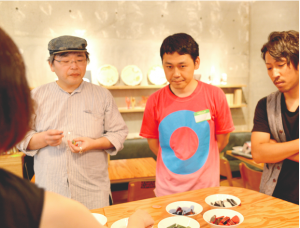
Many products were made by KIGI for PASS THE BATON. The selected public submissions had to be able to face off on even ground against those curated by these top creators. Although the ideas may stem from different places, even these different ideas needed to reflect themselves in a sufficiently attractive way. I truly got the sense that this was Mr. Toyama’s attitude as part of the judging panel. He was always very serious about judging whether or not a submission was truly better than a KIGI creation and if it could shine on an even level with actual products.
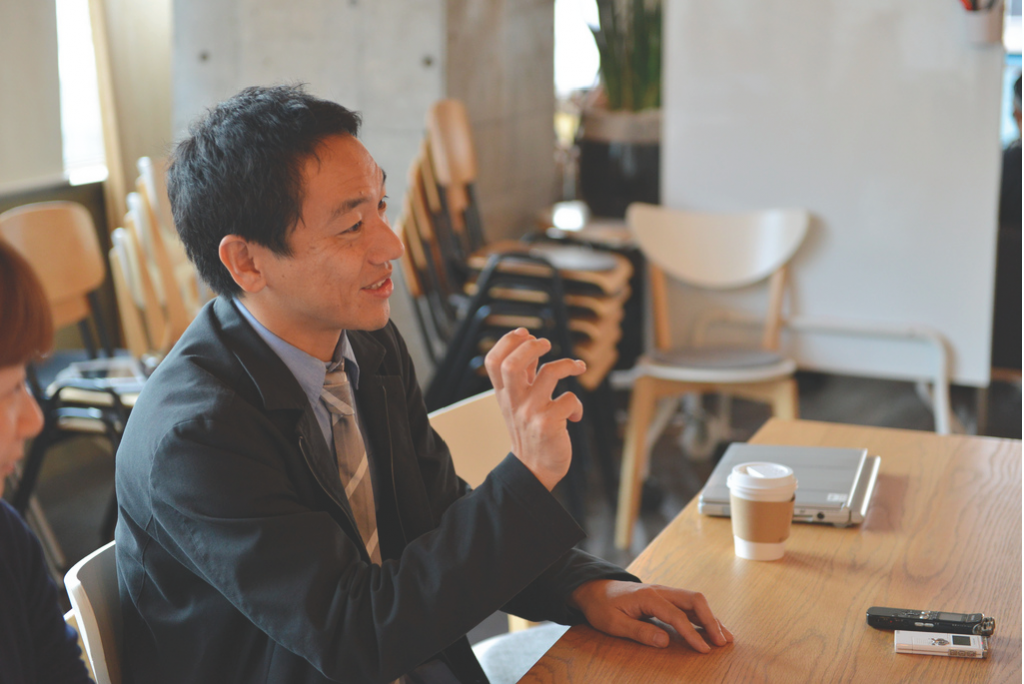
Mr. Morizumi, working as head of the PASS THE BATON division.
Masaumi Morizumi (Mr. Morizumi below): After a submission was selected, I got the sense that holding discussions on commercializing it led to the refinement of creator skills, design expression, and more. To not simply view the design through a computer, but to use one’s hands to create form. The creation of a prototype was one component of evaluation as well.
Ms. Hayashi: One episode during my time on the Kaki (persimmon) judging panel, the first public submission project, “Akasaka Kakiyama” (loftwork.com insert page link here), left an impression on me as well. After Mr. Toyama asked, “What do you think about this idea?”, Mr. Uehara, immediately began cutting paper that was nearby, and Ms. Yoshie then drew on it, after which she placed it on top of a box and tapped on it. Finally, in order to check its completeness as a graphic, she captured it on film using her iPhone. This series of actions was truly an example of “rapid prototyping.”
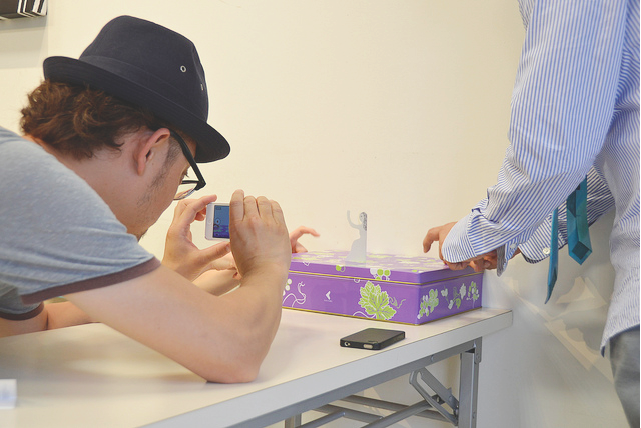
Starting with Mr. Toyama’s idea, Mr. Watanabe drew a young girl on the spot and made her actually dance.
This has been called a recent and new method, but I think this method has probably been around for hundreds of years. Not just to speak, but to use the hands and mind to take action. I realized these were all part of the same set.
Taiwan x Loftwork x PASS THE BATON Workshop Discoveries
I know that you held a prototyping workshop with designers from Taiwan in June of 2013, but please tell us about the sequence of events that led to holding this event.
Ms. Hayashi: Originally, the designers from the Taiwan Design Center came to visit Japan in order to see the Interior Lifestyle international trade fair as part of their young member development program, and it was during that occasion that we first had the idea of holding a workshop. And we thought, if we’re going to hold a workshop, we should have it lead to something interesting. As a result, we consulted with Smiles asking them if they would let us work with items from the “10,000 creators meet PASS THE BATON”, or if they would allow us to enter a submission to them if we had a good idea, and this led to the birth of the workshop.
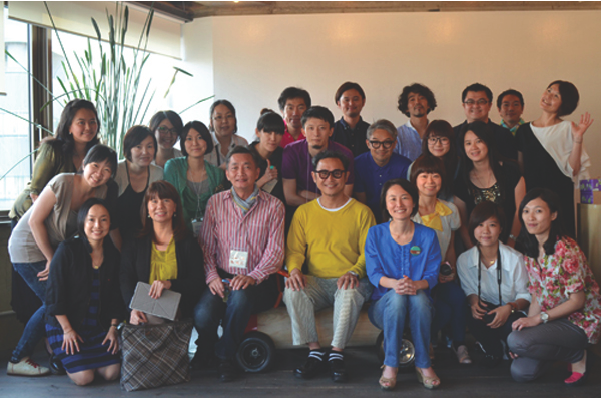
In this workshop, mixed teams made up of Taiwanese and Japanese members worked to create a prototype, and you participated as a facilitator as well. How did you feel as you watched people you had met for the first time collaborate together?
Ms. Hayashi: The participants that gathered were either professional designers or those who strongly wanted to become professional. As a result, there was no need for politics between the participants from Taiwan and Japan. English wasn’t great on either side, but the feeling of “I want to create something good” clashed all over the place. I really felt that this was something great. Without the clashing of ideas, new discoveries cannot be made,and I think those teams that made concessions on this front ended up making compromises.
Regardless of language barriers, if teams go forward without properly discussing what they like, what kind of value they want to create, and other such things, then in the final phase the ideas meander off course. As a result, a miscellaneous mixture of Taiwanese and Japanese tastes ended up showing through the creations of some of the teams.
Even when speaking about diversity across country borders, real diversity is not found through having certain things in common the moment people meet. The importance of true diversity is found only when people’s ideas don’t match and instead clash. I once again felt that “diversity” is truly represented by the idea that “it is easier said than done”. In other words, it’s important to not only assert yourself but to communicate why you are asserting yourself that way. For example, by not just saying “I like red”, but explaining why you like it, why red is an important color, and other background aspects allows you to find an even better solution.
I think that Team Camel, which created a neck warmer made from left over scrap camel fabric, was particularly skilled in this area. From the start, the team really gave off an aura of refusing to compromise. They truly shared the feeling of wanting to create something good, and as their facilitator and interpreter, I saw how they communicated their ideas to one another, and when they grasped the direction they wanted to go in, how they dived tasks, as one person would say “Okay, I’ll write the back story”, “I’ll sew”, “I’ll design the label”, and so forth. I think this surprising output was possible exactly because they were a team of those four. For your information, this neck warmer is in the process of being commercialized.
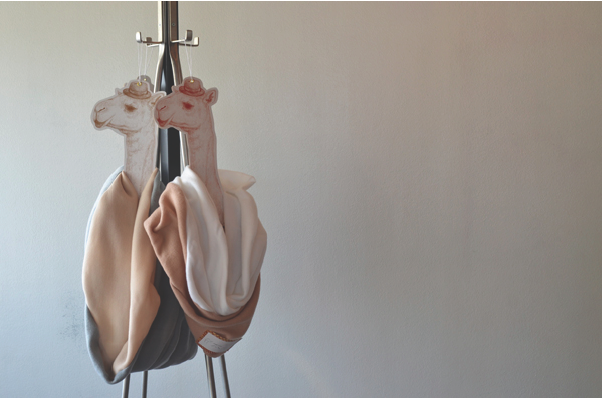
△A stole by Team Camel, made in the workshop using left over scrap camel fabric.
After finishing this workshop, a number of creators spoke of how they truly realized that they are Japanese. Frankly, Japanese designers wanted to subtract. However, designers from Taiwan wanted to add instead. They wanted to decorate. As a result, there was pulling back and forth between wanting to add and subtract. It’s extremely interesting how it seems that Japanese have it passé down in their DNA to find aesthetic beauty in minimizing, just as how in our culture we find a rock garden beautiful.
Designs that Shine Light on the Lost
In the “10,000 creators meet PASS THE BATON” project, the theme of the project involved left over scrap material and recycled goods. I feel like there is something very Japanese about this.
Ms. Hayashi: I may be misunderstood, but I think that in a mature country like Japan, many designs are actually redesigns. The other day, I heard a presentation by a young Chinese female architect regarding her plan for a city, and her idea was to create a new city completely from scratch. On the other hand, what I thought as I judged entries for the good design award was that what we are interested by in Japan these days is not to create something new but to shine light once again on things that have been lost or are no longer used. For example, rediscovering the value of houses with thatched roofs or redesigning areas or towns in decay. I feel that the idea of wanting to recapture those things that improve quality of life is similar to a redesign.
The NEW RECYCLE efforts of PASS THE BATON, and this project, were truly about taking preexisting things and looking at them again from a different point of view in order to recreate them. This can be applied to anything, and it really was a lesson in what is important when looking at something. It’s very exciting, and this perspective can be utilized for a variety of things.
The Inevitable Costs Paid for Value
I see that this project connected companies and designers.
Mr. Morizumi: It’s a very important thing to strive to accomplish something together with a company. Representatives from Familiar and members of the marketing department at Neal’s Yard, both companies that cooperated with us, came to our review of the workshop with Taiwan as well.
Grass-root movements are of course important, but having companies present is also very important. I feel that the fact that we were able to match the two in this case was a great thing. Smiles strives to be a company that can achieve both of these things.
Ms. Hayashi: It must be the culture of Smiles to bring representatives and marketing people to that place. To have not just the ego of the designer present, but to have people who can comment from the sales perspective. This back in forth was really exceptional.
I think that in establishing a successful business, the perspective of making something that sells becomes important.
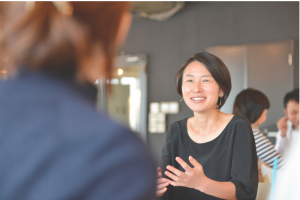
Ms. Hayashi: If all we cared about was having someone say “what a wonderful effort”, I think the original meaning of this project would be lost. What we were in search of was just how much we could make something sellable. The fact that creators commit to this idea is what allows them to give birth to value for society. A designer isn’t someone who creates cool designs. The territory of a designer is continuously expanding, and these days all sorts of things need to be designed, from business models to organizations themselves. A single piece of output from a design process simply becomes a product with form. It starts with wanting to create something that sells. When you respond to a person who thinks a product is “good” with “that’ll be 10,000 yen”, I think the moment they choose to buy it is the moment you know they really did think it was god.
Mr. Morizumi: If you don’t end up being able to make money, you won’t be able to keep going.
Ms. Hayashi: If your vision has value, then it should also be able to make money. How you choose to take this and give it real meaning, and how you expand it, is the business of the matter. Just saying “it’s something nice so it doesn’t matter if I can make money” is wrong because the two should be one in the same. The same as having someone say thank you when you’ve done something nice. It has value so people will pay for that value. There’s pride to be had in creating something that corresponds to that value.
Please give a closing statement.
Ms. Hayashi: I am so happy that we were able to give form to the collaboration between PASS THE BATON, which I admire, everyone from Loftwork, and all the creators who participated with us. I will continue to feel a mix of excitement and nervousness until I see for the first time just how far Loftwork and the union of 10,000 creators can challenge and achieve compared to the level of creativity sought out by PASS THE BATON.
But when I look back at it now once again, I am surprised just how well each submission was chosen, and that we are currently in the concrete product development phase. We will try our best to ensure that this continues on to the next stage of interest.
Finally, we hope you come and purchase our products. Bring your whole family (laughs). Of course, I’ll be there shopping, too!
Chiaki Hayashi is the Co-Founder of the new-style creative agency Loftwork Inc. With 16,000 creators registered, Loftwork functions as a global creative community, and offers integrated creative services including digital communication solutions and innovation design. As its latest projects, Loftwork started “FabCafe,” a global cafe network with Fab machines, as well as “Open CU” as an open learning platform for creative minds.
Chiaki is a certified PMP by the Project Management. She also holds the position of Project Coordinator in Culture and GLAM at Creative Commons and Japan Liaison to the Director at MIT Media Lab.
Chiaki was born in 1971, and grew up in the United Arab Emirates. She graduated from the Faculty of Commerce at Waseda University and received a Masters in Journalism from Boston University. In 1994, she entered Kao Corporation. Belonging to the marketing department, she was in charge of cosmetic products. After leaving the company in 1997, she went to the US and studied at Boston University. After graduating from Boston University’s Graduate School, she worked for Kyodo News in their New York branch, and as a business correspondent she built up a network in American IT companies and among entrepreneurs. After returning to Japan in 2000, she founded Loftwork Inc.
